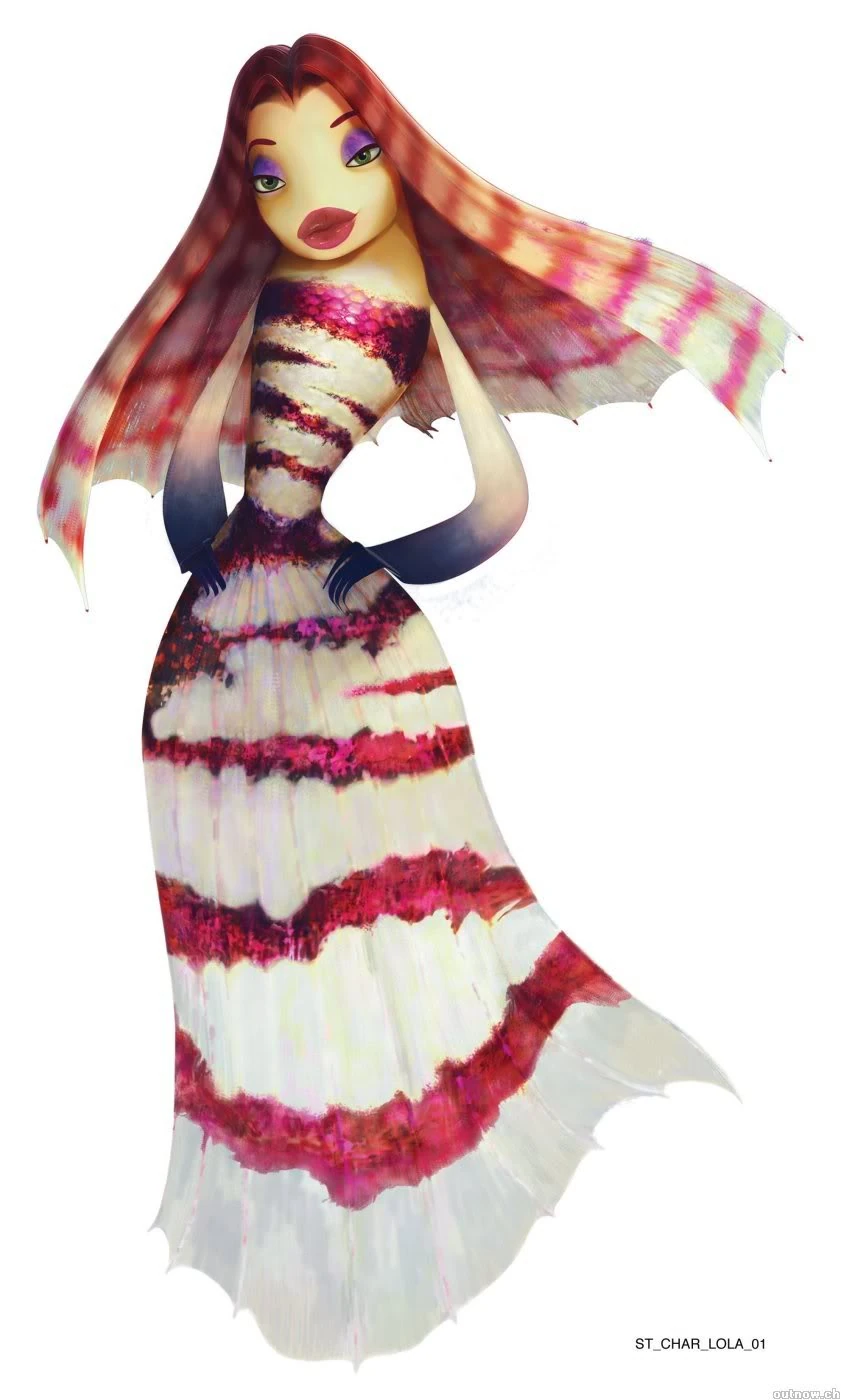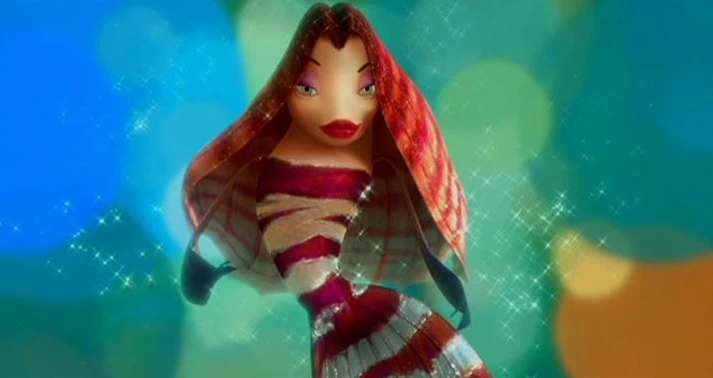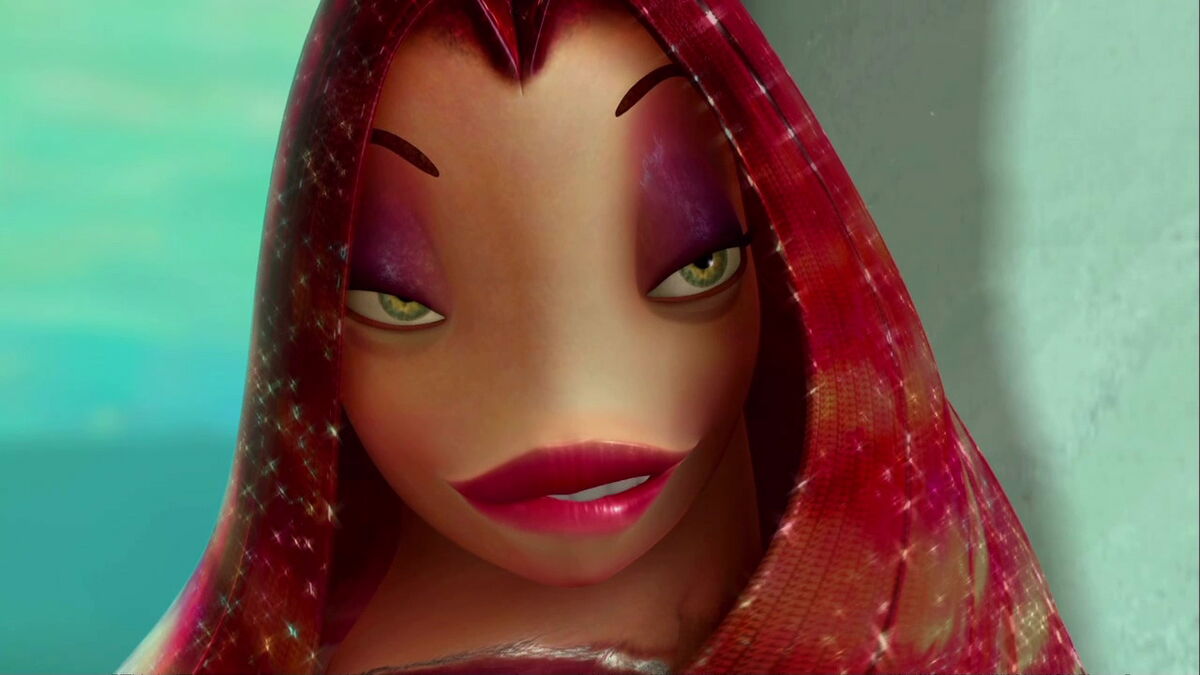The Allure Of Lola From Shark Tale: Anglerfish Diva Unveiled
The animated film "Shark Tale" introduced a vibrant underwater world, teeming with memorable characters, but few captivated audiences quite like Lola from Shark Tale. With her striking appearance and manipulative charm, Lola carved out a niche as one of the movie's most intriguing antagonists. Her character, an alluring yet dangerous lionfish-like creature, brought a layer of complexity to the narrative, showcasing the darker side of ambition and vanity in a seemingly lighthearted children's film.
Beyond her immediate role in the plot, Lola's portrayal raises fascinating questions about character design, the depiction of marine life in popular culture, and the subtle ways animation can explore deeper themes. This article delves into the enigmatic presence of Lola, exploring her character, her impact on the film, and how her fictional world subtly connects to the real-world fascination with marine biology and ancient ocean dwellers.
Who is Lola from Shark Tale? An Enigmatic Character Profile
Lola, voiced by the iconic Angelina Jolie, is one of the most visually distinctive characters in "Shark Tale." She is presented as a femme fatale, a beautiful and cunning fish who uses her looks and wit to manipulate those around her, particularly Oscar, the film's protagonist. Her design, though inspired by a lionfish with its flowing fins and vibrant colors, also incorporates elements of the deep-sea anglerfish in her predatory nature and the way she ensnares her targets.
Her role in the movie is primarily that of a love interest and a temptress for Oscar, drawing him away from his true love, Angie. Lola embodies superficiality and ambition, valuing status and wealth above genuine connection. Her character arc, though not as central as Oscar's or Lenny's, serves as a crucial catalyst for Oscar's journey of self-discovery and his eventual realization of what truly matters. She is a master of deception, her seductive demeanor masking a cold, calculating mind, making her a formidable, albeit secondary, antagonist.
Lola's Character Biography
Lola emerges as a glamorous figure in the bustling underwater metropolis, a place where appearances and social standing seem to dictate worth. Her initial interactions with Oscar are marked by a clear disdain for his low-status job and aspirations. She represents the allure of the "fast life" and the superficial rewards that Oscar initially craves. Her manipulative tactics are evident as she encourages Oscar to maintain his lie about being the "Sharkslayer," seeing it as a means to elevate her own status through association.
Her character reaches a peak of villainy when she physically assaults Oscar out of jealousy and rage after he publicly rejects her for Angie. This moment reveals the true extent of her malice and serves as a stark contrast to her earlier seductive persona. Despite her negative traits, Lola's character is integral to the plot, pushing Oscar to confront his insecurities and ultimately choose integrity over illusion. She is a cautionary tale within the vibrant world of "Shark Tale," reminding viewers that beauty can often hide a darker truth.
Lola's "Personal Data"
While Lola is a fictional character, we can compile some "data" about her role and characteristics within the film's universe:
| Attribute | Detail |
|---|---|
| Species (Fictional) | Lionfish-like/Anglerfish-inspired hybrid |
| Voice Actor | Angelina Jolie |
| Role in Film | Secondary Antagonist, Temptress, Love Interest (for Oscar) |
| Key Traits | Glamorous, Manipulative, Vain, Ambitious, Jealous, Seductive |
| Defining Moment | Physical assault on Oscar after his rejection |
| Relationship to Protagonist | Brief romantic entanglement with Oscar |
| Film Appearance | Shark Tale (2004) |
The Anglerfish Archetype: Fact Versus Fiction in Shark Tale
Lola's character design, while primarily drawing from the lionfish, also subtly evokes the predatory nature of the anglerfish, especially in her ability to lure and ensnare. This artistic liberty is common in animated films, where biological accuracy often takes a backseat to narrative and visual appeal. Real anglerfish, particularly the deep-sea varieties, are known for their bioluminescent lures used to attract prey in the dark abyss. This predatory cunning is mirrored in Lola's calculated charm and her ability to draw Oscar into her web of deceit.
The film takes many liberties with marine biology, presenting sharks as sentient beings who run a crime syndicate and fish who live in a bustling metropolis. This anthropomorphism allows for a relatable story, but it also creates a stark contrast with the realities of the ocean. For instance, the formidable teeth of the sharks in the movie, while visually impressive, are simplified for animation. In the real world, shark dentition is incredibly diverse and specialized. Consider the Bonnethead shark (Sphyrna tiburo), for example, the smallest of its genus, which possesses very characteristic lower anterior teeth used for crushing shellfish, a far cry from the generic sharp teeth often depicted in media.
Lola's Impact: Beyond the Screen and into Pop Culture
Despite her villainous role, Lola from Shark Tale left a lasting impression on audiences. Her distinct voice, striking appearance, and memorable lines contributed to her status as a standout character. She represents a classic archetype in storytelling: the beautiful but dangerous siren who tests the hero's resolve. This archetype resonates across cultures and generations, making Lola's character instantly recognizable and understandable, even in an underwater setting.
Her presence also sparked discussions among viewers about the film's themes of social climbing, authenticity, and the consequences of dishonesty. Lola serves as a foil to Angie's genuine affection, highlighting the superficiality of Oscar's initial desires. In a world increasingly driven by appearances, Lola's character remains relevant as a representation of the pitfalls of prioritizing external validation over true character. Her memorable performance ensured that she became a significant part of "Shark Tale's" legacy, often cited in discussions about the film's most impactful characters.
Dissecting Marine Biology in Shark Tale: A Look at Real Sharks and Lola's Species
While "Shark Tale" is a work of fiction, its setting and characters draw from the rich tapestry of marine life, albeit with significant creative license. Examining the biological accuracy (or lack thereof) in the film can be a fun exercise for marine enthusiasts and paleontologists alike. The movie features various shark species, from the great white to the hammerhead, but their anatomical details are often generalized for animation. This simplification is understandable for storytelling, but it contrasts sharply with the intricate details that fascinate real-world shark tooth enthusiasts.
The Nuances of Shark Dentition: From Bonnetheads to Blockbusters
The teeth of the sharks in "Shark Tale" are designed to look menacing, fitting their roles as intimidating figures. However, real shark teeth are incredibly diverse and specialized, reflecting their diet and hunting strategies. For instance, the Bonnethead shark (Sphyrna tiburo), a species often identified by experienced collectors, has unique lower anterior teeth near the symphysis that are adapted for crushing hard-shelled prey. These are quite distinct from the generalized pointed teeth seen in the movie's sharks. Similarly, identifying fossilized shark teeth requires keen observation. A tooth that is too worn and incomplete for a positive identification, as noted by collectors, highlights the challenges of paleontology compared to the clear-cut designs of animated characters.
The field of fossil identification is a testament to the complexity of real marine biology. Enthusiasts often pore over specimens, seeking to identify species like Notorynchus primigenius, a complete tooth of which is considered quite rare according to books like "Gainesville Sharks Teeth" by Boyd (2016). This level of detail and rarity is something that fictional portrayals often gloss over, but it underscores the incredible diversity and history of life in our oceans. The abraded nature of some fossil teeth, like those of Carcharias samhammeri, further illustrates the natural processes that shape these remnants of ancient life, a stark contrast to the pristine, cartoonish teeth of movie sharks.
Unearthing Marine History: Fossils, Fish Vertebrae, and Fictional Worlds
The deep ocean, both in fiction and reality, holds countless mysteries. While "Shark Tale" presents a vibrant, modern underwater city, the real ocean floor is a treasure trove of ancient history. Many shark teeth one might find are from the Paleozoic era, rather than the more recent Mesozoic or Cenozoic periods, offering a glimpse into millions of years of evolution. These aren't just smooth, perfect specimens; sometimes, what looks like a shark tooth might just be a rock that has been sandblasted and broken into a similar shape, requiring an expert eye to differentiate.
The discovery of mineralized fish vertebrae, often jet black and denser than recent fish bones, sounds like ceramic, is another fascinating aspect of marine paleontology. These findings provide tangible links to ancient marine ecosystems, offering insights into creatures that swam the seas long before modern species. The contrast between the cartilaginous skeletons of sharks and the bony skeletons of fish is a fundamental biological difference that animated films simplify. While a passionate shark tooth enthusiast might be hoping to find a mosasaur tooth or vertebra, even finding a well-preserved fish vertebra can be a rewarding discovery, connecting them to the vast, undocumented history of the ocean that Lola's world only hints at.
The Passion for the Deep: Connecting Fandom to Fossil Hunting
The allure of "Shark Tale Lola" and the film's vivid underwater world mirrors the real-world passion for marine life, whether it's through collecting shark teeth or studying ocean ecosystems. Just as fans dissect character motivations and plot points in a movie, enthusiasts of marine paleontology meticulously identify fossils. "Hi everyone, I had these teeth laying around for a while now and this is my first attempt at even trying to identify shark teeth," is a common sentiment among new collectors, highlighting the journey of discovery and learning. Over time, by collecting, seeing enough teeth, and doing some reading, one picks up a few things, building expertise similar to how movie buffs gain knowledge about film production and character development.
The dedication of a very passionate shark tooth enthusiast and collector is not unlike the dedication of a film critic or a dedicated fan. Both seek to understand, categorize, and appreciate the nuances of their chosen subject. Whether it's identifying a specific shark species like Sphyrna tiburo, the Bonnethead shark, or discussing the artistic choices behind Lola's design, the underlying drive is a deep fascination with the subject matter. This passion bridges the gap between the fictional underwater world of "Shark Tale" and the very real, ancient, and ever-evolving world beneath the waves.
Lola's Legacy: Why She Remains a Memorable Figure
Lola from Shark Tale, despite her relatively brief screen time, left an indelible mark on the film's audience. Her character embodies a timeless archetype that resonates deeply with human experiences of temptation, ambition, and the struggle between superficiality and genuine connection. Angelina Jolie's distinctive voice performance imbued Lola with an undeniable charisma, making her both captivating and unsettling. Her visual design, blending the exotic beauty of a lionfish with the predatory mystique of an anglerfish, made her instantly recognizable and visually striking.
Her legacy extends beyond just being a villain; she is a pivotal character who forces the protagonist, Oscar, to confront his flaws and make a choice that defines his true character. Without Lola's manipulative presence, Oscar's journey of self-discovery would have been less impactful. She represents the seductive dangers of the "glamorous" life, a stark contrast to the honest, hardworking values that ultimately prevail. In the vibrant, often chaotic world of "Shark Tale," Lola serves as a compelling reminder that not all that glitters is gold, and that true value lies beyond superficial appearances.
Exploring the Depths: Further Insights and Discoveries
The world of "Shark Tale" invites us to consider the vastness and mystery of the ocean, both in its animated form and its real-world counterpart. The film's creative interpretations of marine life, while entertaining, also serve as a gateway to exploring the true wonders of the deep. From the intricate biology of species like the Bonnethead shark to the ancient history revealed by fossilized fish vertebrae, the ocean offers endless opportunities for discovery and learning. This journey of exploration is not just for scientists; it's for anyone with a curious mind, just like the passionate collectors who spend hours identifying shark teeth found in various locations.
The Real-World Allure of Shark Tooth Island and Beyond
The fascination with marine life extends far beyond the silver screen. Places like Shark Tooth Island in Wilmington, NC, just off the shore from River Road Park, offer real-world adventures for those eager to connect with ancient marine history. If you're standing at the boat ramp facing the river, the island directly in front of you is Keg Island, a known spot for fossil hunting. These locations are where enthusiasts, much like the "very passionate shark tooth enthusiast and collector" mentioned in the data, can unearth tangible links to the past. The thrill of finding a fossil, even if it's a mineralized fish vertebra rather than a coveted mosasaur tooth, connects individuals to the vast timeline of Earth's oceans.
The journey of identifying a fossil, whether it's a Bonnethead shark tooth or something that looks more like a tiger shark, involves careful observation and comparison, often requiring searches on dedicated forums and reference to books like the one on Gainesville sharks' teeth. This process of learning and discovery mirrors the way we unpack complex characters like Lola from Shark Tale, understanding their nuances and impact. The ocean, in all its forms—fictional or real, ancient or modern—continues to inspire awe, curiosity, and a deep appreciation for the incredible diversity of life on our planet.
Conclusion
Lola from Shark Tale stands as a testament to the power of compelling character design and voice acting in animation. As an anglerfish-inspired femme fatale, she brought a crucial element of conflict and moral complexity to the film, pushing Oscar towards his ultimate redemption. Her manipulative charm and striking appearance ensured her place as one of the movie's most memorable figures, sparking conversations about themes of ambition, vanity, and authenticity.
Beyond her narrative role, Lola's fictional world subtly connects us to the very real and fascinating realms of marine biology and paleontology. From the distinct dentition of real sharks like the Bonnethead to the ancient history revealed by fossilized fish vertebrae, the film's animated ocean serves as a playful contrast to the scientific wonders of our planet's aquatic ecosystems. We hope this deep dive into Lola's character and the broader marine world has enhanced your appreciation for both the artistry of "Shark Tale" and the incredible complexity of life beneath the waves. What are your thoughts on Lola's impact? Share your insights in the comments below, or explore our other articles on marine life and animated classics!

Lola | Shark Tale Wiki | Fandom

Lola | Shark Tale Wiki | Fandom

Lola (Shark Tale)/Gallery | Villains Wiki | Fandom